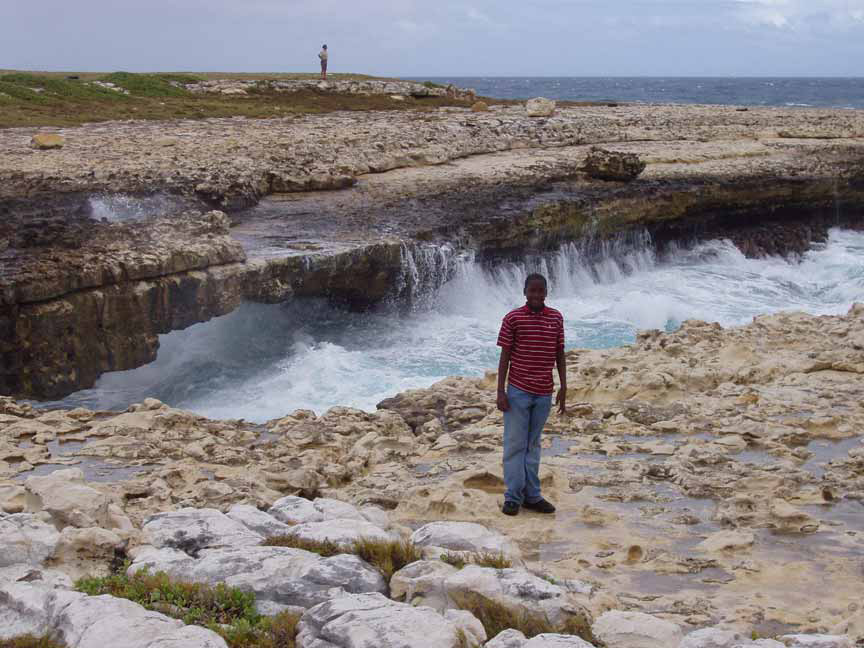Jolly Harbour, Antigua - Island Tour

|
17:03.970N 61:53.031W After the excitement of the rainforest canopy tour, Rick decided to stick to activities nearer and dearer to his heart - like running and playing golf. So while Rick was playing golf, Don, Margy and I went on a tour of the island with our favorite taxi driver, Michael, and his eleven year old son, Little Michael. Little Michael was on vacation from school for the holidays and when we asked him if he was glad he was on vacation, he answered in the way that only kids can - completely honestly. 'No I would rather be at school.' he said. He had one of his school books with him and read part of it to me at one point, so I think he really was serious. Little Michael goes to one of the private schools on the island - which is a common theme throughout the islands we have visited so far. The West Indian parents we have spoken to - taxi drivers, bartenders, waiters and waitresses, etc. - seem to all have their kids in private school. Hmmm... doesn't say much for the public school systems. Anyway, on with the tour. Antigua, in general, is fairly prosperous. It is probably not as wealthy as St. Maarten, but all of the villages are fairly tidy and most of the people seem to be employed in some fashion. We have never felt unsafe here and everyone has been quite friendly - especially if we reach out to them first with a 'good afternoon' or a 'Happy New Year'. The responses we get are always enthusiastic. When we asked Michael what the top industry was here in Antigua, not surprisingly he answered, 'tourism'. When we asked what came in second, he said, 'tourism, tourism, tourism'. Understandable. All the islands we have seen are beautiful, but Antigua is less crowded than St. Maarten and some of the Virgin Islands, and has a very ragged coast, resulting in what they claim to be 365 beaches - pretty good for an island less than 200 square miles in size. The Atlantic side of the island is a little more rugged and the Caribbean side a little more lush, with the green covered mountains and rainforest in between. Michael took us on a clockwise circumnavigation of the island, stopping to point out and sometimes have us sample the local vegetation. Like roasted corn on the cob. Sold by an ancient woman on the side of the road. The ears are supplied in small paper bags with a husk or two thrown in to be used as napkins. The kernels are big, some of them blackened, extremely chewy with a flavor not too different from popcorn - chewy popcorn. Next were tiny, grape-sized apples that could be either sour or sweet - he said you can't tell which until you try them. Like any good taxi driver, he tried them for us first, declared them sweet and picked a bunch for us. We drove by a field of Antiguan black pineapples (no samples) - who knew pineapples didn't grow on trees? (Obviously I didn't.) Michael pointed out many other local plants and explained how they used them for cooking or medicines, etc., but probably only Margy, who is a plant person, remembers all the details. The first scenic stop we made was Devil's Bridge. This is on the rugged Atlantic side of the island and only accessible via a road pretty much past its prime. The wind was brisk and a squall blew in just after we arrived, but we had time to take in the view and get a few pictures. Picture 1 shows Little Michael standing in front of one of the 'blow holes'. We tried to get a good picture of the spray coming up through the holes in the rock, but were only semi-successful. The second scenic stop was Shirley Heights. This is one of the highest (maybe the highest?) points on the Antigua coast and was used back in the 1700's and early 1800's by the British to keep an eye on the French over on the island of Guadeloupe. The British fort is mostly gone, but the view is still there and is spectacular. The wind at this height was almost howling and the view of the Atlantic impressive as we watched a storm make it's way across the sea to envelop us on the island. The coming storm is shown in Picture 2 with Margy, Michael and Don looking on. Note the 'Cliff Edge' sign and the cement pylons. Michael said the pylons were added after some distraught person purposely drove their car over the edge into the Atlantic. Ugh. The third and last scenic stop was Falmouth Harbour, English Harbour and Nelson's Dockyard. The dockyard, which was used by the British navy has been restored to its original condition, and is an active dockyard and marina for pleasure boaters. Picture 3 is the view of Falmouth and English Harbours from Shirley Heights (English Harbour in the foreground, Falmouth in the background). We plan to stop here with our boat to clear customs before we head to Martinique. That's it for the tour. It gave us a much better feel for the island than just seeing the beaches and marinas from the boat. As Michael put it when I told him this, 'Well, you can't see the sea through the water'. I think this is an Antiguan version of 'you can't see the forest through the trees'. At any rate, we saw the bigger picture of the island and were glad for it. Our New Year's adventures will follow in the next entry. Anne |


